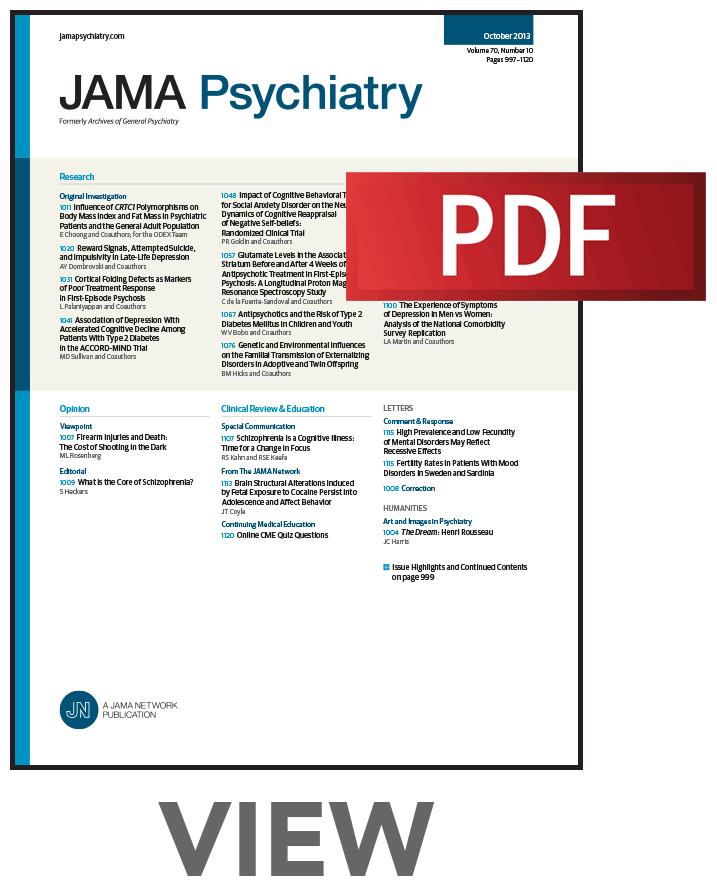Positive Emotion Dysregulation in Opioid Use Disorder and Normalization by Mindfulness-Oriented Recovery Enhancement: A Secondary Analysis of a Randomized Clinical Trial.
IF 22.5
1区 医学
Q1 PSYCHIATRY
引用次数: 0
Abstract
Importance It remains unknown whether difficulties in positive emotion regulation (ER) drive opioid use disorder (OUD) and whether these difficulties may be remediated. Objective To test whether OUD is associated with attenuated positive ER and whether such positive emotion dysregulation may be treated by mindfulness-based intervention. Design, Setting, and Participants In this mechanistic substudy of a randomized clinical trial, patients with chronic pain who did and did not meet criteria for OUD (OUD+ and OUD-, respectively) were recruited from primary care and pain clinics in Utah from January 2016 to and January 2020 and completed a positive ER task and questionnaires. A subsample of participants at risk for opioid misuse were randomized 1:1 to 8 weeks of Mindfulness-Oriented Recovery Enhancement (MORE) or supportive group (SG) therapy and then completed the ER task at posttreatment and questionnaires through 3-month follow-up. Data were analyzed from December 2022 to June 2024. Main Outcomes and Measures The primary mechanistic outcome was parietal late positive potential (LPP) and P300 amplitude during positive ER. Secondary outcomes included self-reported anhedonia, positive affect, attention to positive information, and opioid craving. Results The 160 participants used opioids for a mean (SD) duration of 9.7 (8.4) years, and 98 participants (61.3%) were classified as OUD+. Mean (SD) participant age was 53.7 (11.9) years, and 102 participants (63.8%) were female. A significant group × task strategy (View, Regulate) interaction was observed during positive ER, characterized by the OUD+ group exhibiting lower LPP responses during Regulate compared to View trials relative to the OUD- group (B = 1.91; 95% CI, 0.85-2.96; P < .001). A significant group × strategy interaction was also observed for the P300 (B = 1.40; 95% CI, 0.14-2.67; P = .03). LPP blunting during positive ER mediated the association between OUD status and elevated opioid craving. In the treatment subsample (n = 62), patients treated with MORE showed greater increases in the LPP during Regulate compared with View trials than patients treated with SG (B = 1.53; 95% CI, 0.33-2.73; P = .01). Additionally, MORE improved attention to positive information (B = 1.32; 95% CI, 1.14-5.57; P = .004), positive affect (B = 4.73; 95% CI, 1.22-8.24; P = .01), and anhedonia (B = 2.94; 95% CI, 0.58-5.31; P = .02) while reducing craving (B = -10.88; 95% CI, -21.29 to -0.48; P = .04) to a greater extent than SG. Higher positive ER efficacy predicted lower craving at follow-up (B = -2.38; 95% CI, -4.55 to -0.21; P = .03). Conclusions and Relevance OUD among patients with chronic pain is characterized by difficulties in positive ER, evident in neurophysiological markers of salience detection and emotional elaboration. In this study, training in mindfulness and savoring via MORE enhanced positive ER, which in turn reduced craving, indicating that interventions that normalize reward system function may remediate OUD. Trial Registration ClinicalTrials.gov Identifier: NCT02602535.阿片类药物使用障碍中的积极情绪失调和正念导向恢复增强的正常化:一项随机临床试验的二次分析。
目前尚不清楚积极情绪调节(ER)的困难是否驱动阿片类药物使用障碍(OUD),以及这些困难是否可以补救。目的检验OUD是否与正性ER减弱相关,以及正性情绪失调是否可以通过正念干预进行治疗。设计、环境和参与者在这项随机临床试验的机制亚研究中,从2016年1月至2020年1月在犹他州的初级保健和疼痛诊所招募了符合和不符合OUD标准(分别为OUD+和OUD-)的慢性疼痛患者,并完成了阳性的ER任务和问卷调查。有阿片类药物滥用风险的参与者子样本随机分为1:1至8周的正念导向恢复增强(MORE)或支持小组(SG)治疗,然后在治疗后完成ER任务并通过3个月的随访完成问卷调查。数据分析时间为2022年12月至2024年6月。主要结果和测量主要机制结果为ER阳性时的顶叶晚期正电位(LPP)和P300振幅。次要结果包括自我报告的快感缺乏、积极影响、对积极信息的关注和阿片类药物渴望。结果160名参与者使用阿片类药物的平均(SD)持续时间为9.7(8.4)年,98名参与者(61.3%)为OUD+。参与者平均(SD)年龄为53.7(11.9)岁,102名参与者(63.8%)为女性。在正ER期间,观察到显著的组与任务策略(View, regulation)相互作用,其特征是与View试验相比,OUD+组在调节试验中表现出较低的LPP反应(B = 1.91;95% ci, 0.85-2.96;p < 0.001)。P300也存在显著的组与策略交互作用(B = 1.40;95% ci, 0.14-2.67;p = .03)。内质网阳性时LPP变钝介导了OUD状态与阿片渴望升高之间的关联。在治疗亚样本(n = 62)中,与View试验相比,接受MORE治疗的患者在调节试验期间的LPP增加幅度大于接受SG治疗的患者(B = 1.53;95% ci, 0.33-2.73;p = 0.01)。此外,MORE提高了对积极信息的注意(B = 1.32;95% ci, 1.14-5.57;P = 0.004),积极影响(B = 4.73;95% ci, 1.22-8.24;P = 0.01),快感缺乏(B = 2.94;95% ci, 0.58-5.31;P = .02)而减少渴望(B = -10.88;95% CI, -21.29 ~ -0.48;P = .04)的差异大于SG。较高的阳性内质反应效能预示着随访时较低的渴望(B = -2.38;95% CI, -4.55 ~ -0.21;p = .03)。结论:慢性疼痛患者存在ER阳性困难的特点,在显著性检测和情绪阐述等神经生理指标上表现明显。在这项研究中,正念训练和通过更多的品尝增强了正内啡肽,这反过来又减少了渴望,表明使奖励系统功能正常化的干预可能会纠正OUD。临床试验注册号:NCT02602535。
本文章由计算机程序翻译,如有差异,请以英文原文为准。
求助全文
约1分钟内获得全文
求助全文
来源期刊

JAMA Psychiatry
PSYCHIATRY-
CiteScore
30.60
自引率
1.90%
发文量
233
期刊介绍:
JAMA Psychiatry is a global, peer-reviewed journal catering to clinicians, scholars, and research scientists in psychiatry, mental health, behavioral science, and related fields. The Archives of Neurology & Psychiatry originated in 1919, splitting into two journals in 1959: Archives of Neurology and Archives of General Psychiatry. In 2013, these evolved into JAMA Neurology and JAMA Psychiatry, respectively. JAMA Psychiatry is affiliated with the JAMA Network, a group of peer-reviewed medical and specialty publications.
 求助内容:
求助内容: 应助结果提醒方式:
应助结果提醒方式:


